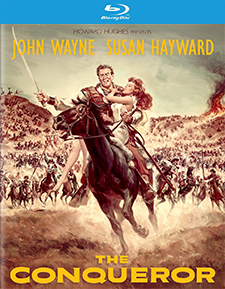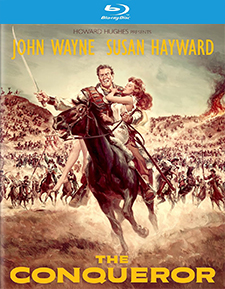Conqueror, The (Blu-ray Review)

Director
Dick PowellRelease Date(s)
1956 (February 25, 2025)Studio(s)
RKO Radio Pictures (Kino Lorber Studio Classics)- Film/Program Grade: C
- Video Grade: A
- Audio Grade: A-
- Extras Grade: B
Review
1956 saw large-scale productions from all the major studios: United Artists (Around the World in 80 Days), Paramount Pictures (The Ten Commandments), Warner Bros. (Giant), 20th Century Fox (The King and I), Columbia Pictures (Picnic), and MGM (Lust for Life). Not to be outdone by its competitors, RKO, under the leadership of Howard Hughes, released The Conqueror, an epic featuring two major stars in a sweeping fictionalized historical drama.
Termujin, (John Wayne, The Searchers) a feared Mongol warrior later known as Genghis Khan, abducts Bortai (Susan Hayward, I’ll Cry Tomorrow), daughter of the Tartar chieftain who defeated Termujin’s father in battle, from her soon-to-be husband Targutai (Leslie Bradley, Westward Ho, the Wagons!). Refusing to subjugate herself to Termujin, Bortai uses her wiles to pit him against his blood brother Jamuga (Pedro Armendariz, Native Drums). Eventually, however, she falls in love with Termujin. Termujin’s mother, Hunan (Agnes Moorehead, Endora on TV’s Bewitched), pops up occasionally to glower and foretell tragedy, cautioning her son that Bortai means only trouble. But Termujin is smitten and believes he can tame her fiery temper and win her affection.
This soap opera, set against a scenic stand-in for the Gobi desert, is often laughable for its missteps. The first is the screenplay by Oscar Millard with stiff dialogue written in a cornball suggestion of old-fashioned English. One example of the florid writing occurs when Jamuga urges Termujin not to attack the caravan carrying Princess Bortai and Termujin replies in John Wayne’s unmistakable drawl, “There are moments for wisdom, Juh-mooga, then I listen to you. And there are moments for action; then I listen to my blood. I feel this Tartar wuh-man is fer me, and my blood says, ‘TAKE HER.’” Another occurs when, facing his Tartar princess, Termujin looks into her eyes with a mixture of passion and suspicion, stating “Yer beautiful in yer wrath. I shall keep you, Bortai! I shall keep you, and, in responding to my passions, yer hatred will kindle into love!” Given such silly lines and preposterous delivery, it’s impossible to accept Termujin as remotely authentic.
Wayne in the title role is monumental miscasting. He looks foolish in his elaborate Mongol costumes and sounds even worse when reciting the dopey dialogue. Maybe because most of the film is consumed by tribal battles on horseback, Wayne felt he’d fit in nicely, but the role-and-actor match is deadly.
The casting of Susan Hayward as the female lead is also a misfire. A few make-up tweaks to slant her eyebrows upward do little to convince an audience that this glamorous, auburn-haired Hollywood star is a 15th-century Tartar, and her petulant performance is no help. To be fair, she’s the victim of a bad script and a weak director. Her Bortai seems addle-brained when she initially spurns Termujin and wishes him dead and then, without much reason, falls into his arms in a loving embrace. As we watch her, it’s easy to imagine that she was thinking, “What am I doing in this mess of a picture?”
The director of The Conqueror, Dick Powell, is best known as an actor (Murder, My Sweet). Powell couldn’t rescue the picture from its dismal script and miscasting of the stars but, to his credit, the battle scenes look very good, with a huge number of hard-riding extras, well-staged stunts, and lots of somersaulting horses. This was well before CGI, so every person and horse you see is real.
For an action picture, there’s a surfeit of exposition that involves multiple rival tribes and many unfamiliar names that are hard to keep track of, and mucks up a simple story with unnecessary details. The film’s entertainment value lies in how laughable it is. Wedged in among the battle scenes, there are musicians playing around a campfire, a musical production number in a chieftain’s palace with dancing girls made to look nearly nude in beige body suits, a fire juggler, a dancing bear, and a decked-out camel to add visual “splendor.” Susan Hayward even has an embarrassing dance solo concluding with an attempt on Termujin’s life.
At a cost of $6 million, The Conqueror was the most expensive film ever made by RKO. Howard Hughes spared no expense, believing the film would be his masterpiece. The widescreen CinemaScope images are often breathtaking, and Victor Young’s score gives the action scenes a sense of grandeur.
The Conqueror holds a sad distinction. It was shot in Utah’s Escalante valley in 1954, downwind of a lake bed where the Atomic Energy Commission had tested eleven nuclear weapons two years before. Many of the people involved with the production were aware of the nearby tests and the possibility of fallout, but few at the time considered it much of a health threat. During filming, levels of radiation were high. By 1980, 91 of the 220 cast and crew had been diagnosed with cancer, including Wayne, Hayward, Armendariz, and Moorehead.
The Conqueror made a profit worldwide during its theatrical release, though it was critically panned. Shortly thereafter, Hughes pulled it from theatrical and TV release. This was the last film he personally produced. He loved it so much that he purchased it back and watched it often.
The Conqueror was shot by directors of photography Joseph LaShelle, William E. Snyder, Leo Tover, and Harry J. Wild on 35 mm Technicolor film, processed photochemically, and presented in the aspect ratio of 2.55:1. The Blu-ray is sourced from a master provided by Universal. The picture is free from major imperfections, such as scratches and embedded dirt specks. The Technicolor photography is especially noteworthy in the wide outdoor scenes, many featuring action sequences. The red earth, steep cliffs, colorful tribal clothing, and costumed dancing girls make for a rich palette of bold primary hues and earthy tones. Details such as Termujin’s attire, the caravan conveying Bortai, men’s facial hair, and horses’ manes are nicely delineated. Sixty tons of red earth were transported to RKO for studio shooting to match location footage. Actors, primarily white, wear heavy make-up to make them look Asian, but Susan Hayward is all Hollywood glamour, looking very much a movie star.
The soundtrack is English 2.0 DTS-HD Master Audio. English SDH subtitles are available. Dialogue is clear, though it is stilted and was meant to sound ancient. Wayne never delivers his lines believably. There’s always that cowboy drawl in his readings. Sound effects include horses charging, hand-to-hand combat, grunts and groans, crackling fire, and whistling arrows. In some of the studio-shot scenes set outdoors, there’s an echo-y quality that suggests a closed interior. Victor Young’s score does a good job of heightening excitement during the action scenes but tends to sound like elevator music in scenes that should generate suspense.
Bonus materials on the Region A Blu-ray release from Kino Lorber Studio Classics include the following:
- Audio Commentary by Film Historian David Del Valle and Film Historian/Producer Dan Marino
- Trailer (3:12)
- Legend of the Lost Trailer (3:43)
- The Horse Soldiers Trailer (2:39)
- Brannigan Trailer (2:23)
- David and Bathsheba Trailer (2:43)
- I Want to Live! Trailer (2:12)
- Back Street Trailer (2:25)
Audio Commentary – After Howard Hughes bought RKO Studios, he became notorious for slashing the work force. He always felt that movies were a business whose primary priority was to make money. If art was achieved in the process, all well and good. John Wayne had agreed to a three-picture deal with RKO and had just starred in the successful The High and the Mighty. Both his career and Susan Hayward’s were at their peak. Wayne was one of the most famous actors in the world. The cast propelled The Conqueror to success. Wayne was regarded in the industry as lacking a broad range and he was eager to expand his work beyond Westerns. Genghis Khan changed history, and Wayne gravitated to The Conqueror after getting a look at an early draft of the script. Marlon Brando, who had achieved critical acclaim as Brutus in Julius Caesar, was RKO’s first choice, and the script was written with him in mind, but Wayne was more bankable than Brando at the time. To compete with television, studios felt they had to offer big, colorful films with scope. The Conqueror “is a film that should not have been made.” Dick Powell was chosen to direct because he had scored a hit with Split Second. He was out of his depth, yet “soldiered on.” Susan Hayward refused to be deglamorized and often held up production with hair, make-up, and photography demands. Rather than a Tartar woman, she looks like a “pin-up queen,” taking the viewer completely out of the movie. She said that Wayne was her favorite leading man. John Wayne took the greatest hammering from critics, but went on to win a Best Actor Oscar for True Grit over a decade later. Susan Hayward won a Best Actress Oscar for 1958’s I Want to Live! The commentators discuss the Hollywood tradition of “yellow face,” which is on full display in The Conqueror. The term refers to Caucasian actors playing Asian roles. All major roles in the film are played by non-Asians. About a third of the commentary is devoted to the controversy about the filming location, close to a former nuclear testing site. Over the years, more and more members of the production got cancer from residual radiation. By 1980, 41% of cast and crew had become afflicted with the disease. The U.S. eventually acknowledged a degree of culpability for nearby residents and paid out $2 billion. In closing, the commentators note that The Conqueror “stands as a haunting artifact... of overreach,” a hollow shell in pursuit of power.
There are many bad movies but The Conquerer, because of its scope, its script, and its stars, stands above them. It’s a colossal misfire that reflects the misguided intentions of Hughes, Powell, and Wayne, all of whom regarded the picture as a potential winner. Maybe there was a degree of hubris on Wayne’s part, thinking he could add a bit of Western flair to his Mongol warrior. The final picture reflects a confluence of circumstances that doomed it.
- Dennis Seuling

